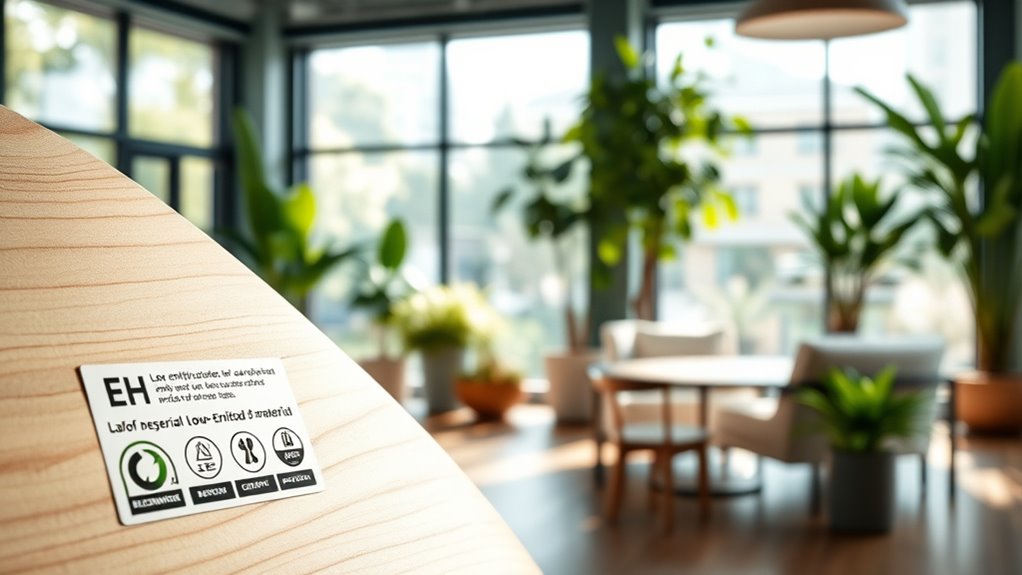To earn LEED points for low-emitting materials, you should select products certified by trusted third-party standards like GREENGUARD or FloorScore, which verify VOC emissions meet strict indoor air quality criteria. Review product datasheets to confirm certification and low VOC content, ensuring your choices support healthier indoor environments. Prioritizing certified, low-emission materials not only helps you achieve LEED credits but also creates a safer, more sustainable space—more tips await if you keep exploring.
Key Takeaways
- Select materials with third-party certifications like GREENGUARD or FloorScore to verify low VOC emissions.
- Document VOC content and certification status to demonstrate compliance for LEED credit submission.
- Prioritize low-emitting adhesives, paints, and finishes to improve indoor air quality and earn LEED points.
- Use certified products to reduce ventilation and filtration costs, supporting LEED’s indoor environmental quality criteria.
- Incorporate low-emitting materials strategically to maximize LEED points and demonstrate commitment to occupant health.

To earn points for low-emitting materials in LEED, you need to understand how choosing these products can improve your building’s indoor air quality and meet certification standards. Low-emitting materials are designed to emit fewer volatile organic compounds (VOCs), which are often found in adhesives, sealants, paints, and finishes. VOC reduction is vital because high levels of these compounds can compromise indoor air quality, leading to health issues like headaches, respiratory problems, and allergies. By selecting products with low VOC emissions, you create a healthier environment for occupants and advance your project toward LEED certification.
Choosing low-emitting materials improves indoor air quality and supports LEED certification standards.
Material certification plays a significant role in this process. Certifications such as GREENGUARD, FloorScore, or LEED’s Material Ingredients credit help verify that materials meet strict VOC emission limits and other environmental standards. When you choose certified products, you gain confidence that they have been independently tested and meet rigorous indoor air quality criteria. This not only simplifies your documentation process but also ensures compliance with LEED requirements. Material certification acts as a quality assurance, reducing the risk of selecting products that might emit harmful pollutants over time.
As you evaluate materials, pay close attention to product datasheets and certification labels. These documents provide critical information on VOC levels and certification status. You should prioritize products that explicitly state low VOC content and carry recognized certifications. This proactive approach helps you avoid future issues and supports your project’s overall sustainability goals. Remember, the goal isn’t just to meet minimum standards but to select materials that actively contribute to better indoor air quality and occupant well-being.
Incorporating low-emitting materials with proper VOC reduction measures also benefits your project’s long-term performance. Reduced emissions mean less need for costly air filtration or ventilation adjustments later on. It can also improve the building’s overall environmental profile, making it more attractive to tenants or buyers who prioritize health and sustainability. Additionally, many LEED credits reward the use of products with third-party certifications, so choosing certified materials can help maximize your points potential.
Ultimately, understanding the importance of VOC reduction and material certification allows you to make informed decisions when selecting low-emitting materials. It’s a strategic move that benefits the health of building occupants, enhances indoor air quality, and simplifies your pathway to LEED certification. By prioritizing certified, low-VOC products, you demonstrate a commitment to sustainability and occupant well-being, positioning your project for success in the LEED rating system. Recognizing the role of third-party certifications in verifying VOC emissions can further streamline your material selection process.
Frequently Asked Questions
How Do Low-Emitting Materials Impact Overall Project Costs?
Low-emitting materials can increase your project costs initially due to higher material prices, but they often lead to savings in long-term health benefits and energy efficiency. You should consider your budget considerations carefully, as material costs may be higher, but the overall value, including improved indoor air quality and potential LEED points, can outweigh these expenses. Balancing upfront costs with long-term benefits is key to managing your project’s finances effectively.
Are There Specific Certifications for Low-Emitting Materials?
Yes, there are specific certifications for low-emitting materials. You can look for eco labels and certification standards like GREENGUARD, FloorScore, and FSC, which verify low emissions and sustainable practices. These labels help you identify materials that meet strict environmental criteria, making it easier to earn LEED points. By choosing certified products, you guarantee healthier indoor air quality and demonstrate your commitment to sustainable building practices.
How Do LEED Requirements Vary by Building Type or Region?
You’ll find LEED requirements vary based on your building’s region and type. Regional building codes influence standards for low-emitting materials, ensuring local environmental priorities are met. You should also perform a material lifecycle analysis to evaluate environmental impacts from production to disposal. By considering these factors, you can tailor your project to meet specific LEED criteria, earning points and promoting sustainable building practices suited to your location and building type.
What Challenges Exist in Sourcing Low-Emitting Materials?
Sourcing low-emitting materials can be challenging because of limited material availability and inconsistent supplier transparency. You might struggle to find sustainable substances that meet LEED standards, and some suppliers hesitate to share detailed ingredient information. This lack of clarity complicates your compliance efforts, forcing you to hunt harder, verify more thoroughly, and often settle for less sustainable options, which can hinder your progress toward achieving green building goals.
Can Existing Buildings Qualify for LEED Points Based on Material Updates?
Yes, existing buildings can qualify for LEED points through material updates. You can improve indoor air quality by replacing or upgrading materials with low-emitting options, which also positively impacts the material lifecycle. Focus on selecting materials that reduce VOC emissions and are durable, ensuring long-term benefits. By updating these elements, you demonstrate a commitment to healthier indoor environments and sustainable material use, earning valuable LEED points.
Conclusion
By choosing low-emitting materials, you can earn valuable LEED points and improve indoor air quality. Did you know buildings using low-emitting materials can reduce VOC levels by up to 75%? This not only benefits occupant health but also boosts your project’s sustainability credentials. So, make smart material choices to maximize LEED points and create healthier, more environmentally friendly spaces. Your efforts can truly make a difference in building a greener future.










